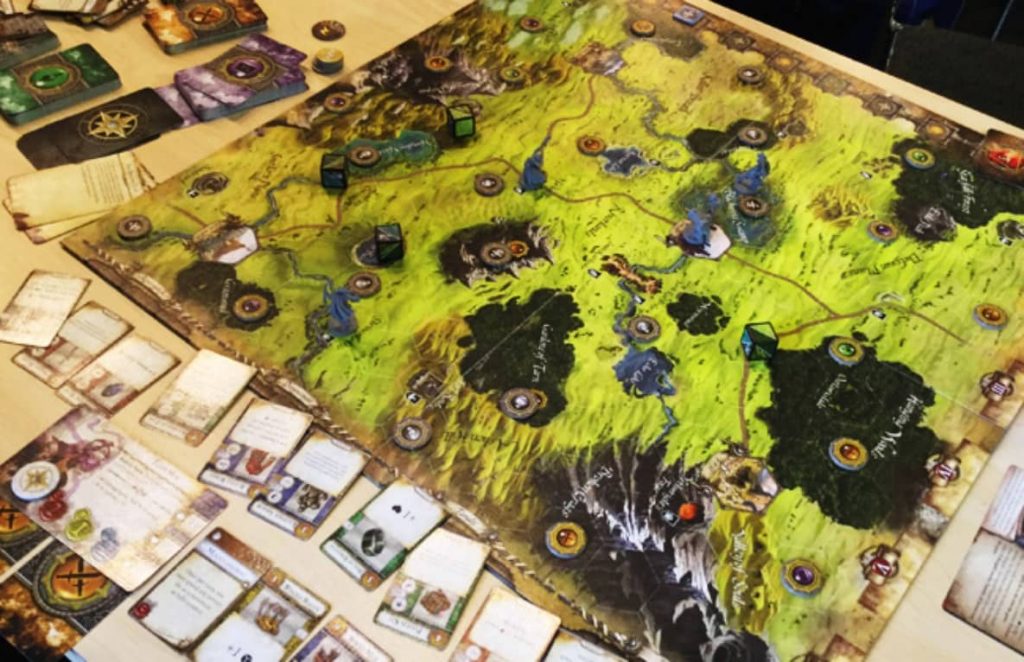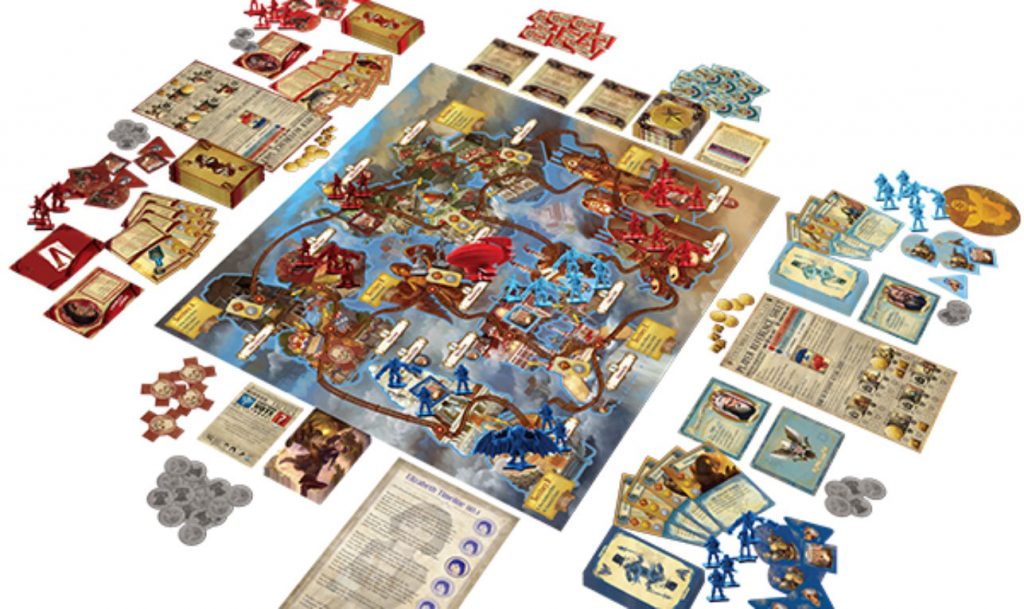Kylie: In Vladimír Suchý’s heavy management game Underwater Cities, players are competing to build the ultimate deep sea nation. But is it actually better, down where it’s wetter? Are there no troubles when life is the bubbles? Can we really trust a crustacean that sings? I guess we should find out.
Each player is given a personal city map which you’ll fill with a scattering of white and red biodomes, which will connect to a flourishing network of factories and laboratories. Ideally, this network will score you points, as well as act as an engine that’ll occasionally spew out resources such as credits, biomatter, and kelp. Lots of kelp.
Apparently when we colonise the seas, the only thing available to eat will be kelp. I’ve never tried kelp. Have you tried kelp? They tell me it’s the kale of the sea, but I’m pretty sure that’s a lie.
Pictured above is the game’s shared central board. To build your undersea civilisation, you need to play cards from your hand to use an action on this board. However, this is much deeper than it seems at first glance (sea what I did there?).
The action slots on the central board, together with the cards in your hand, are all coloured. If you can play a card to a slot that’s the same colour, then you’ll get to perform both the action on the slot and the action on the card. Thus, each game you play will see you having to adapt your schemes depending on what cards you’ve been dealt. Doesn’t sound so hard? Well, I should mention that your hand limit is a mere three cards.
This limitation means that every card you either choose to play or discard becomes a very weighty decision. Do you stockpile green cards, which are the strongest in the game, but risk the green slots on the board becoming blocked by other players? Or do you try and get an even spread of colours, allowing more flexibility?
There are some really interesting decisions in the way that you might try and use your hand, and in what buildings you choose to incorporate into your network. When you’ve got some experience, players can also throw in ‘government contracts’ which give you rewards for being the first to reach a certain requirement. There are also two sides to the player mats, shaking up the possible placements of the buildings, offering up yet more tricky decisions.
All of this makes for a superbly brain-burning puzzle. However, for such a uniquely moist game, these decisions are so… dry.
There’s just no personality here. There’s no room to create something distinctive. There’s a certain joy you get from other city building games like Suburbia when, at the end, you glance down at your suburbian paradise of parks and lakes, whilst the player next to you has built an authoritarian police state and someone else has just built a wasteland, with airports and outlet malls as far as the eye can see.
The eponymous cities of Underwater Cities always turn out to be a series of white or red domes with coloured discs around the edges, connected by strips of cardboard. From a strategic point of view there are some fascinating decisions regarding what to place in your network, but from the point of view of what is commonly known as “fun”, you’re just churning out vanilla ice-cream. No added toppings, syrups or flavour. Whatever way you look at it, it’s just plain.
What’s more odd is how Underwater Cities manages to be both long, yet at the same time difficult to settle into. Because you only get three turns per round, there’s a stop, start, stop, start nature to the game which makes it hard to find a groove. Despite this, it’s a long game, almost excruciatingly so at a full 4 players, making it a game for just 2-3 people.
But even then, I still ended up longing for interaction. You have next-to-no impact on other players’ cities. You can take the action slots that they need on the central player board, yet this rarely feels as affecting as it does in other worker placement games, which can feel not just restrictive, but downright vicious – the oft-used analogy of a knife fight in a phone booth comes to mind. In Underwater Cities it instead feels like your most efficient choice is now reduced to a slightly less efficient choice. What’s more, players will only rarely ‘steal’ a spot to stop you using it, as they tend to be so focused on their own endeavours. It’s less a knife fight in a phone booth, more ‘two busy people apologetically trying to squeeze down the same corridor.’
Equally underwhelming is your underwater economy. One of your aims in Underwater Cities is to whip up an engine that will produce resources, enabling upgrades and further development. But your engine will only produce resources three times throughout the course of the game, and only two of these phases can actually aid in your expansion. For me, engine-building games often feel addictive due to the sense of progress – you watch your plans come to life as you turn your crank further and further, going from a dribble of scarce resources to a veritable fountain of goodies spilling out into your lap. With only two functional production phases in Underwater Cities, there’s very little feeling of advancement or evolution.
Worse still, production itself is a fiddly beast. It’s easy to become engulfed by admin in this phase, first counting up buildings, then working out how many are of certain sizes, checking card effects, and finally checking your rules reference. The whole process feels like cross-referencing a spreadsheet, which is something I’ve never particularly Excel-ed at.
And so long as we’re all riding the Complain Train, the components in this game are pretty sub-par, too. The player aids and mats in particular are very flimsy, and it’s easy for parts of your network to shift around when you lean in to put your tokens on the board or grab a new card – watch those elbows!
The artwork doesn’t really do anything for me, either. The cards in particular have a corporate and boring theme to them. They could have had such fun with a sea theme, but instead they just put multiple pictures of boardrooms and people on the phone. One of the cards has you ‘Organise a Conference’. Erm, why?
That said, as soon as I saw the art on the orange personal assistant I couldn’t help think he looked an awful lot like the rapper Xzibit, and then I couldn’t stop thinking about some sort of spinoff to Pimp my Ride.
Although, Pimp my Symbiotic City Dome doesn’t really have the same ring to it. Probably best to stick to cars. Although how about an expansion: Pimp my Submarine?
“Yo dog! I heard you like engine building, so we put an engine builder in your city builder so that you can build while you build.”
From the card play, to the city building, to the engine development, all of these interconnected sections do beg a question: is Underwater Cities more than the sum of its parts? SU&SD favourite Great Western Trail is a game that follows this formula well – it has a bunch of disparate sections from developing your herd of cattle, to hopping around a board to use different locations, to racing your train down a track. Yet that game all comes together into a cohesive whole, laden with hugely enjoyable strategic choices and long-term planning.
Underwater Cities never quite achieves this. The transient nature of your options, from the cards in your hand to the spots available on the board at any one time means you’re just… doing what’s best for you at that point. Grand plans never feel like they gain momentum, because you simply cannot guarantee that you’ll ever be able to follow through with them.
The fact is, city building has been done better, worker placement has been done better, and engine building has been done better and with oodles more character. Cramming these elements together into a single game is an ambitious task, but one that ultimately doesn’t cohere. There is undoubtedly an impressive tactical puzzle to be found in aligning card play with slots on the board, but that’s nowhere near enough to make me keep playing. Like the 1995 movie, Waterworld, there are some interesting ideas here, but ultimately it’s a bit waterlogged (and almost certainly too long).
Sorry Sebastian! This one is a bit more Otoh Gunga than Atlantica. Maybe next time.











